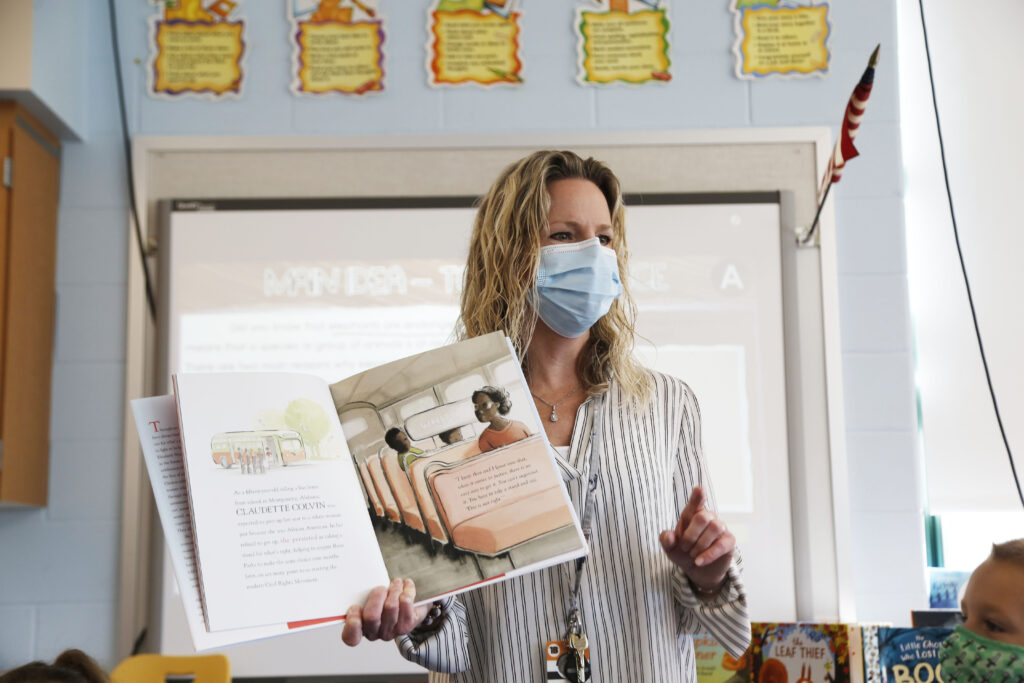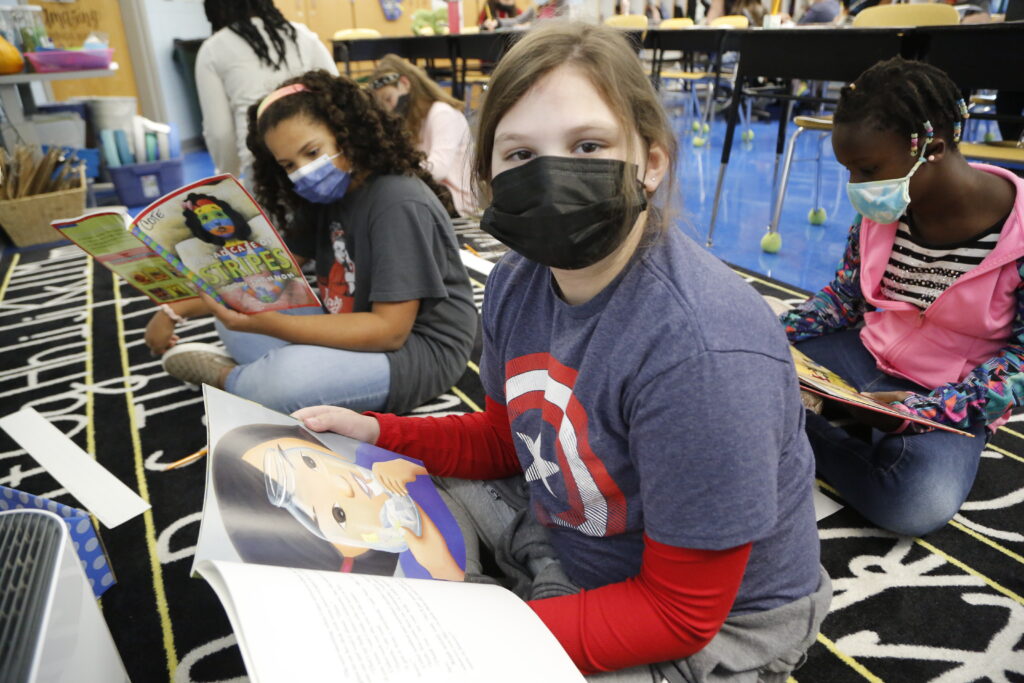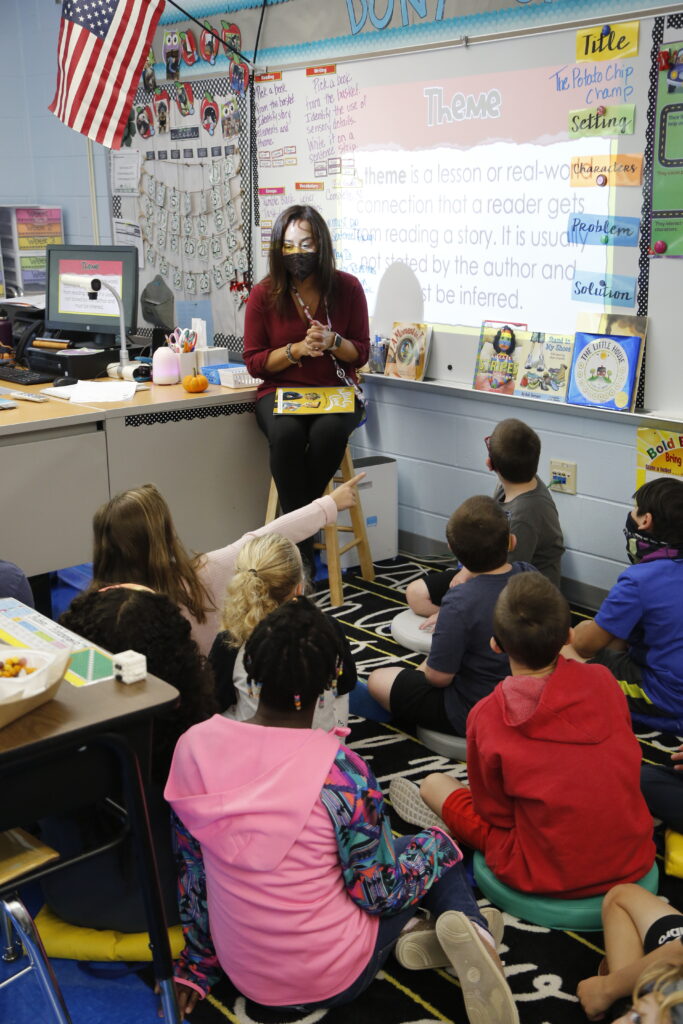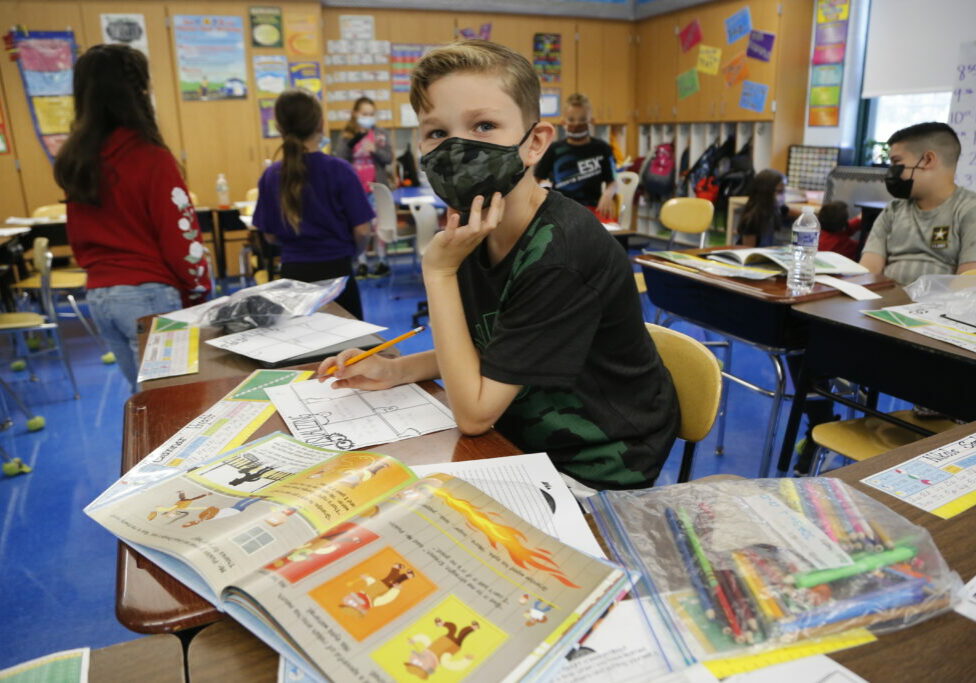By Kathryn Coulibaly
Sparking a love of reading at any age is valuable, but navigating a pandemic, technology issues, economic disadvantages and a return to in-person instruction that left students struggling, Barnegat third-grade teacher Kerinn Ruthven and fourth grade teacher Kimberly Cote knew they needed to be creative, innovative and consistent if they were going to get their students on the right page.
“When students aren’t proficient at reading, they shut down,” Cote said. “They doubt their abilities and think they’re not as smart as other students. Often, it leads to behavior issues, or just a disconnection from the rest of the class. It affects their self-esteem.”
Ruthven agreed.
“When students can read but can’t perform as well in math, it just doesn’t affect their confidence the same way,” Ruthven said. “We know that reading is the key to everything. If we can unlock that, we can address every other area.”

Strategies to develop reading skills
Cote and Ruthven are both veteran teachers, currently teaching at Joseph T. Donahue Elementary School in Barnegat. Ruthven has been teaching for 24 years and Cote is in her 16th year teaching. In the 2020-21 school year, Ruthven’s third grade class had the most growth in English language arts (ELA) and math among all the third grade classes in the district. Together, Cote and Ruthven worked to develop strategies to help their students develop their reading skills knowing that every day was critical.
“We start with a read-aloud every day,” Ruthven said. “We go over focus skills and theme, discussing in general what the theme means, how to find what the theme is and what the main idea is. We read a little and then stop and talk about it as a whole group. That keeps everyone engaged. We might not read the full book in one sitting. Sometimes, we will divide the book up over a few days and leave them in a cliffhanger and talk about it. What do they think will happen? What do they think about the choices the characters are making? Have they ever been in a similar situation? Does this remind them of another book we have read or they have read? We really want the students to connect with what we are reading.”
“We try to hit multiple skills at the same time,” Cote said. “We go back and forth between fiction and nonfiction and talk about— ‘this is make-believe, this is real.’ We talk about reading as a writer, and I encourage the students to copy the style of writers they enjoy.”
Cote also uses writers’ notebooks and has them write down verbs and other parts of speech.
One of the most popular ways for students to engage with reading are the hands-on projects. Both teachers enjoy getting students to do arts and crafts projects related to the texts they read.
“That stuff is very important,” Ruthven said. “We do interactive notebooks, flip books, foldables, vocabulary foldables, task cards and more.”
“When we read a story about snowy owls, we make snowy owls using cotton balls,” Cote said. “It gives the students a sense of accomplishment and gets them following directions. It’s creative and something they can show their parents and gets them engaged at home talking about the book and the lesson. We want parents to be involved and interested in what we’re doing in the classroom.”
Another popular activity is book tastings. The teachers arrange new books like menu selections. Students can watch book commercials and read small sections of each title. The goal is to explore many new titles to spark students’ interest.
“We also love to do ‘character walks,’” Cote said. “We pretend we are specific characters and use character trait skills to talk, think and act like that character. When we finish books, we often write an additional chapter or add ideas for how the book would go if it were a series.”

Learning how to be together again
Both teachers also incorporate a lot of group activities that give students opportunities to interact with each other. “Our kids really need to learn how to be with each other again, especially in a school setting,” Ruthven said.
“We’re taking a good look at each student as an individual and trying to figure out what they need,” Cote said. “We figure out where the gaps are in their learning. One of the areas that we wanted to work on with some students is phonemic awareness, so we used Rhyme Magic, and that made a big difference. We piloted that with some students and then tried it the next year with higher level students.”
Each teacher has created a classroom full of color and art and with an abundance of books and plenty of spaces to read them. Reading happens everywhere—at the front of the room on a carpet as a group, individually at their desks, in small groups at tables working with the teachers or aides, if available, and in smaller groups of two or three.
When the teachers read to the class, they are animated and rely heavily on audience participation.
“We know that we have to put on a show every day,” Cote said. “We can’t be boring; we have to be spectacular.”
“The thinking used to be that students had about one minute of attention span equal to their age; so for third grade, you had about eight or nine minutes of attention span,” Ruthven said. “In fourth grade, you had nine or 10 minutes. In the pandemic era, we’re finding that to be even lower.”
Helping students believe in themselves
The two teachers find that breaking ELA up throughout the day helps to incorporate it while being realistic about what students are able to tolerate.
“We encourage students to pick up a book that we’ve already read with the class,” Ruthven said. “Because we’ve already read it together, they know the story. They can reread it on their own and be more confident with it. Repetition helps them master words and boosts their confidence, and that’s what we need in order to get them to take the leap to the next level. We need them to believe that they can make that leap successfully.”
“People don’t understand what reading does for kids’ confidence,” Cote said. “It’s everything. It helps them with their peers. If they’re struggling to read, everyone in the classroom knows it, and they’re going to hear about it on the playground or at the bus stop. We need to build our students up in every way, and we need to help our other students build empathy. We spend a lot of time on that in our classrooms. Every child wants to feel like they belong, that they are accepted. They cannot do their best work if they are afraid to make a mistake or look foolish. So we have to build a classroom atmosphere that is supportive and kind.”
Both teachers have invested a lot of time and money selecting books that will entice and engage students. Students have ready access to plenty of books at their individual reading levels in the classroom, although they might not have access at home.
“Many of our students are economically disadvantaged,” Ruthven said. “Officially, the number is about 35 percent, but even students who are technically not economically disadvantaged might not be growing up in homes that value reading.”

Reading for pleasure in an electronic age
According to the National Endowment for the Arts, that decline in reading has been building for some time. In “Reading at Risk: A Survey of Literary Reading in America,” researchers found that fewer than half of adult Americans read for enjoyment in 2002, instead preferring electronic media, including television and video games. Knowing the explosion of social media and streaming and the portability of digital entertainment since this survey was conducted, it is likely that few children are being exposed to reading as entertainment at home, although some certainly are.
In a survey conducted by the National Assessment of Education Progress (NAEP) in 2019 and 2020, the number of American 9- and 13-year olds who are reading for fun on a daily basis are at the lowest levels since the 1980s. According to the report, 42% of 9-year old students reported they read for fun almost every day. Sixteen percent of 9-year olds say they never or hardly ever read for fun.
There is a huge difference between female students and male students on this question. According to NAEP, 46% of female 9-year old students said they read for fun almost every day. Thirty-eight percent of male 9-year old students reported reading for enjoyment almost every day.
Of course, NAEP also found a correlation between students who reported reading for fun and improved test scores. While test scores are an important indicator, they are not a goal in and of themselves. Focusing on testing can also ignore a crucial element, one that Cote and Ruthven are eager to see and include in their classrooms: joy.
“After everything our kids have been through, after the isolation of the past few years, after the challenges their families have faced, maybe losing a loved one or economic hardships, we want our students to be happy to be back here with us,” Cote said. “We want them to be as happy to be back in person with us as we are to be with them. We want our time together in the classroom to be full of the joy of discovery and learning. It’s about filling them up with light and love, not about testing and remediation.”
Kathryn Coulibaly is the associate editor of the NJEA Review and provides content and support to njea.org. She can be reached at kcoulibaly@njea.org.
Kerinn Ruthven’s Favorite Books for 3rd graders
- Maybe: A Story About the Endless Potential in All of Us
by Kobi Yamada and Gabriella Barouch - Salt In His Shoes: Michael Jordan in Pursuit of a Dream
by Deloris Jordan, Roslyn M. Jordan - Animals Nobody Loves by Seymour Simon
- We are Water Protectors by Carole Lindstrom and
Michaela Goade - Ten Beautiful Things by Molly Griffin and Maribel Lechuga
Kim Cote’s Favorite Books for 4th graders
- Fish in a Tree by Lynda Mullaly Hunt
- Tales of a Fourth Grade Nothing by Judy Blume
- The Sandwich Swap by Queen Rania of Jordan Al Abdullah
- An A From Miss Keller by Patricia Polacco
- The Boy Who Grew a Forest: The True Story of Jadav Payeng by Sophia Gholz and Kayla Harren
